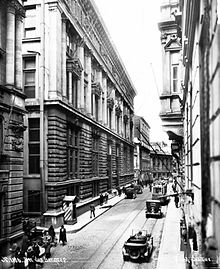Bankalar Caddesi
Although most of the grand 19th-century buildings that line both sides of the street have survived into the 21st century, they are increasingly being converted into hotels, restaurants and cultural centres.
The southern stop of Tünel (1875), the world's second oldest subterranean railway line after London's Underground (1863), is just minutes' walk away from the eastern end of Bankalar Caddesi.
The street's name is written as Voyvoda Yolu (Voivode Road) in the 17th-century Seyahatnâme of Ottoman Turkish traveller Evliya Çelebi.
[9] At the top of the Camondo Stairs, on Kart Çınar Sokak, the street running parallel with Bankalar Caddesi, are a couple of reminders of the period in the 14th century when this part of Beyoğlu was governed by the Genoese.
The most comprehensive survey of these buildings was carried out for an exhibition in 2000 and the information was published in a richly illustrated book called Bankalar Caddesi: Voyvoda Street from Ottoman Times to Today, edited by historian Edhem Eldem.





